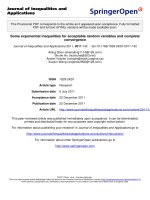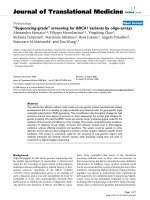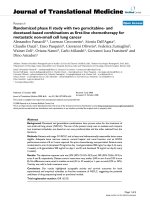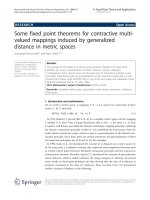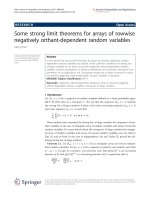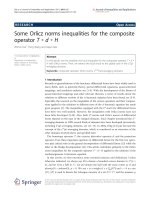báo cáo hóa học:"Some exponential inequalities for acceptable random variables and complete convergence" docx
Bạn đang xem bản rút gọn của tài liệu. Xem và tải ngay bản đầy đủ của tài liệu tại đây (220.16 KB, 14 trang )
This Provisional PDF corresponds to the article as it appeared upon acceptance. Fully formatted
PDF and full text (HTML) versions will be made available soon.
Some exponential inequalities for acceptable random variables and complete
convergence
Journal of Inequalities and Applications 2011, 2011:142 doi:10.1186/1029-242X-2011-142
Aiting Shen ()
Shuhe Hu ()
Andrei Volodin ()
Xuejun Wang ()
ISSN 1029-242X
Article type Research
Submission date 6 July 2011
Acceptance date 22 December 2011
Publication date 22 December 2011
Article URL />This peer-reviewed article was published immediately upon acceptance. It can be downloaded,
printed and distributed freely for any purposes (see copyright notice below).
For information about publishing your research in Journal of Inequalities and Applications go to
/>For information about other SpringerOpen publications go to
Journal of Inequalities and
Applications
© 2011 Shen et al. ; licensee Springer.
This is an open access article distributed under the terms of the Creative Commons Attribution License ( />which permits unrestricted use, distribution, and reproduction in any medium, provided the original work is properly cited.
Some exponential inequalities for acceptable
random variables and complete convergence
Aiting Shen
1
, Shuhe Hu
1
, Andrei Volodin
∗2
and Xuejun Wang
1
1
School of Mathematical Science, Anhui University,
Hefei 230039, China
2
Department of Mathematics and Statistics, University of Regina, Regina
Saskatchewan S4S 0A2, Canada
∗
Corresponding author:
Email addresses:
AS:
SH:
XW:
December 14, 2011
Abstract
1
Some exponential inequalities for a sequence of acceptable random variables
are obtained, such as Bernstein-type inequality, Hoeffding-type inequality. The
Bernstein-type inequality for acceptable random variables generalizes and improves
the corresponding results presented by Yang for NA random variables and Wang et
al. for NOD random variables. Using the exponential inequalities, we further study
the complete convergence for acceptable random variables.
MSC(2000): 60E15, 60F15.
Keywords: acceptable random variables; exponential inequality; complete conver-
gence.
1 Introduction
Let {X
n
, n ≥ 1} be a sequence of random variables defined on a fixed probability space
(Ω, F, P ). The exponential inequality for the partial sums
n
i=1
(X
i
− EX
i
) plays an
important role in various proofs of limit theorems. In particular, it provides a measure
of convergence rate for the strong law of large numbers. There exist several versions
available in the literature for independent random variables with assumptions of uniform
boundedness or some, quite relaxed, control on their moments. If the independent case is
classical in the literature, the treatment of dependent variables is more recent.
First, we will recall the definitions of some dependence structure.
Definition 1.1. A finite collection of random variables X
1
, X
2
, . . . , X
n
is said to be
negatively associated (NA) if for every pair of disjoint subsets A
1
, A
2
of {1, 2, . . . , n},
Cov{f(X
i
: i ∈ A
1
), g(X
j
: j ∈ A
2
)} ≤ 0, (1.1)
whenever f and g are coordinatewise nondecreasing (or coordinatewise nonincreasing)
such that this covariance exists. An infinite sequence of random variables {X
n
, n ≥ 1} is
NA if every finite subcollection is NA.
Definition 1.2. A finite collection of random variables X
1
, X
2
, . . . , X
n
is said to be
negatively upper orthant dependent (NUOD) if for all real numbers x
1
, x
2
, . . . , x
n
,
P (X
i
> x
i
, i = 1, 2, . . . , n) ≤
n
i=1
P (X
i
> x
i
), (1.2)
2
and negatively lower orthant dependent (NLOD) if for all real numbers x
1
, x
2
, . . . , x
n
,
P (X
i
≤ x
i
, i = 1, 2, . . . , n) ≤
n
i=1
P (X
i
≤ x
i
). (1.3)
A finite collection of random variables X
1
, X
2
, . . . , X
n
is said to be negatively orthant
dependent (NOD) if they are both NUOD and NLOD. An infinite sequence {X
n
, n ≥ 1}
is said to be NOD if every finite subcollection is NOD.
The concept of NA random variables was introduced by Alam and Saxena [1] and
carefully studied by Joag-Dev and Proschan [2]. Joag-Dev and Proschan [2] pointed out
that a number of well-known multivariate distributions possesses the negative association
property, such as multinomial, convolution of unlike multinomial, multivariate hyperge-
ometric, Dirichlet, permutation distribution, negatively correlated normal distribution,
random sampling without replacement, and joint distribution of ranks. The notion of
NOD random variables was introduced by Lehmann [3] and developed in Joag-Dev and
Proschan [2]. Obviously, independent random variables are NOD. Joag-Dev and Proschan
[2] pointed out that NA random variables are NOD, but neither NUOD nor NLOD implies
NA. They also presented an example in which X = (X
1
, X
2
, X
3
, X
4
) possesses NOD, but
does not possess NA. Hence, we can see that NOD is weaker than NA.
Recently, Giuliano et al. [4] introduced the following notion of acceptability.
Definition 1.3.
We say that a finite collection of random variables
X
1
, X
2
, . . . , X
n
is
acceptable if for any real λ,
E exp
λ
n
i=1
X
i
≤
n
i=1
E exp(λX
i
). (1.4)
An infinite sequence of random variables {X
n
, n ≥ 1} is acceptable if every finite subcol-
lection is acceptable.
Since it is required that the inequality (1.4) holds for all λ, Sung et al. [5] weakened
the condition on λ and gave the following definition of acceptability.
Definition 1.4. We say that a finite collection of random variables X
1
, X
2
, . . . , X
n
is
acceptable if there exists δ > 0 such that for any real λ ∈ (−δ, δ),
E exp
λ
n
i=1
X
i
≤
n
i=1
E exp(λX
i
). (1.5)
An infinite sequence of random variables {X
n
, n ≥ 1} is acceptable if every finite subcol-
lection is acceptable.
3
First, we point out that Definition 1.3 of acceptability will be used in the current
article. As is mentioned in Giuliano et al. [4], a sequence of NOD random variables with
a finite Laplace transform or finite moment generating function near zero (and hence
a sequence of NA random variables with finite Laplace transform, too) provides us an
example of acceptable random variables. For example, Xing et al. [6] consider a strictly
stationary NA sequence of random variables. According to the sentence above, a sequence
of strictly stationary and NA random variables is acceptable.
Another interesting example of a sequence {Z
n
, n ≥ 1} of acceptable random variables
can be constructed in the following way. Feller [7, Problem III.1] (cf. also Romano and
Siegel [8, Section 4.30]) provides an example of two random variables X and Y such that
the density of their sum is the convolution of their densities, yet they are not independent.
It is easy to see that X and Y are not negatively dependent either. Since they are bounded,
their Laplace transforms E exp(λX) and E exp(λY ) are finite for any λ. Next, since the
density of their sum is the convolution of their densities, we have
E exp(λ(X + Y )) = E exp(λX)E exp(λY ).
The announced sequence of acceptable random variables {Z
n
, n ≥ 1} can be now con-
structed in the following way. Let (X
k
, Y
k
) be independent copies of the random vector
(X, Y ), k ≥ 1. For any n ≥ 1, set Z
n
= X
k
if n = 2k + 1 and Z
n
= Y
k
if n = 2k. Hence,
the model of acceptable random variables that we consider in this article (Definition 1.3)
is more general than models considered in the previous literature. Studying the limiting
behavior of acceptable random variables is of interest.
Recently, Sung et al. [5] established an exponential inequality for a random variable
with the finite Laplace transform. Using this inequality, they obtained an exponential
inequality for identically distributed acceptable random variables which have the finite
Laplace transforms. The main purpose of the article is to establish some exponential
inequalities for acceptable random variables under very mild conditions. Furthermore, we
will study the complete convergence for acceptable random variables using the exponential
inequalities.
Throughout the article, let {X
n
, n ≥ 1} be a sequence of acceptable random variables
and denote S
n
=
n
i=1
X
i
for each n ≥ 1.
Remark 1.1. If {X
n
, n ≥ 1} is a sequence of acceptable random variables, then {−X
n
, n ≥
4
1} is still a sequence of acceptable random variables. Furthermore, we have for each n ≥ 1,
E exp
λ
n
i=1
(X
i
− EX
i
)
= exp
−λ
n
i=1
EX
i
E exp
λ
n
i=1
X
i
≤
n
i=1
exp (−λEX
i
)
n
i=1
E exp(λX
i
)
=
n
i=1
E exp(λ(X
i
− EX
i
)).
Hence, {X
n
− EX
n
, n ≥ 1} is also a sequence of acceptable random variables.
The following lemma is useful.
Lemma 1.1. If X is a random variable such that a ≤ X ≤ b, where a and b are finite
real numbers, then for any real number h,
Ee
hX
≤
b − EX
b − a
e
ha
+
EX − a
b − a
e
hb
. (1.6)
Proof. Since the exponential function exp(hX) is convex, its graph is bounded above
on the interval a ≤ X ≤ b by the straight line which connects its ordinates at X = a and
X = b. Thus
e
hX
≤
e
hb
− e
ha
b − a
(X − a) + e
ha
=
b − X
b − a
e
ha
+
X − a
b − a
e
hb
,
which implies (1.6).
The rest of the article is organized as follows. In Section 2, we will present some
exponential inequalities for a sequence of acceptable random variables, such as Bernstein-
type inequality, Hoeffding-type inequality. The Bernstein-type inequality for acceptable
random variables generalizes and improves the corresponding results of Yang [9] for NA
random variables and Wang et al. [10] for NOD random variables. In Section 3, we will
study the complete convergence for acceptable random variables using the exponential
inequalities established in Section 2.
2 Exponential inequalities for acceptable random vari-
ables
In this section, we will present some exponential inequalities for acceptable random vari-
ables, such as Bernstein-type inequality and Hoeffding-type inequality.
5
Theorem 2.1. Let {X
n
, n ≥ 1} be a sequence of acceptable random variables with
EX
i
= 0 and EX
2
i
= σ
2
i
< ∞ for each i ≥ 1. Denote B
2
n
=
n
i=1
σ
2
i
for each n ≥ 1. If
there exists a positive number c such that |X
i
| ≤ cB
n
for each 1 ≤ i ≤ n, n ≥ 1, then for
any ε > 0,
P (S
n
/B
n
≥ ε) ≤
exp
−
ε
2
2
1 −
εc
2
if εc ≤ 1,
exp
−
ε
4c
if εc ≥ 1.
(2.1)
Proof. For fixed n ≥ 1, take t > 0 such that tcB
n
≤ 1. It is easily seen that
|EX
k
i
| ≤ (cB
n
)
k−2
EX
2
i
, k ≥ 2.
Hence,
Ee
tX
i
= 1 +
∞
k=2
t
k
k!
EX
k
i
≤ 1 +
t
2
2
EX
2
i
1 +
t
3
cB
n
+
t
2
12
c
2
B
2
n
+ · · ·
≤ 1 +
t
2
2
EX
2
i
1 +
t
2
cB
n
≤ exp
t
2
2
EX
2
i
1 +
t
2
cB
n
.
By Definition 1.3 and the inequality above, we have
Ee
tS
n
= E
n
i=1
e
tX
i
≤
n
i=1
Ee
tX
i
≤ exp
t
2
2
B
2
n
1 +
t
2
cB
n
,
which implies that
P (S
n
/B
n
≥ ε) ≤ exp
−tεB
n
+
t
2
2
B
2
n
1 +
t
2
cB
n
. (2.2)
We take t =
ε
B
n
when εc ≤ 1, and take t =
1
cB
n
when εc > 1. Thus, the desired result
(2.1) can be obtained immediately from (2.2).
Theorem 2.2. Let {X
n
, n ≥ 1} be a sequence of acceptable random variables with
EX
i
= 0 and |X
i
| ≤ b for each i ≥ 1, where b is a positive constant. Denote σ
2
i
= EX
2
i
and B
2
n
=
n
i=1
σ
2
i
for each n ≥ 1. Then, for any ε > 0,
P (S
n
≥ ε) ≤ exp
−
ε
2
2B
2
n
+
2
3
bε
(2.3)
and
P (|S
n
| ≥ ε) ≤ 2 exp
−
ε
2
2B
2
n
+
2
3
bε
. (2.4)
6
Proof. For any t > 0, by Taylor’s expansion, EX
i
= 0 and the inequality 1 + x ≤ e
x
, we
can get that for i = 1, 2, . . . , n,
E exp{tX
i
} = 1 +
∞
j=2
E(tX
i
)
j
j!
≤ 1 +
∞
j=2
t
j
E|X
i
|
j
j!
= 1 +
t
2
σ
2
i
2
∞
j=2
t
j−2
E|X
i
|
j
1
2
σ
2
i
j!
(2.5)
.
= 1 +
t
2
σ
2
i
2
F
i
(t) ≤ exp
t
2
σ
2
i
2
F
i
(t)
,
where
F
i
(t) =
∞
j=2
t
j−2
E|X
i
|
j
1
2
σ
2
i
j!
, i = 1, 2, . . . , n.
Denote C = b/3 and M
n
=
bε
3B
2
n
+ 1. Choosing t > 0 such that tC < 1 and
tC ≤
M
n
− 1
M
n
=
Cε
Cε + B
2
n
.
It is easy to check that for i = 1, 2, . . . , n and j ≥ 2,
E|X
i
|
j
≤ σ
2
i
b
j−2
≤
1
2
σ
2
i
C
j−2
j!,
which implies that for i = 1, 2, . . . , n,
F
i
(t) =
∞
j=2
t
j−2
E|X
i
|
j
1
2
σ
2
i
j!
≤
∞
j=2
(tC)
j−2
= (1 − tC)
−1
≤ M
n
. (2.6)
By Markov’s inequality, Definition 1.3, (2.5) and (2.6), we can get
P (S
n
≥ ε) ≤ e
−tε
E exp {tS
n
} ≤ e
−tε
n
i=1
E exp{tX
i
} ≤ exp
−tε +
t
2
B
2
n
2
M
n
. (2.7)
Taking t =
ε
B
2
n
M
n
=
ε
Cε+B
2
n
. It is easily seen that tC < 1 and tC =
Cε
Cε+B
2
n
. Substituting
t =
ε
B
2
n
M
n
into the right-hand side of (2.7), we can obtain (2.3) immediately. By (2.3), we
have
P (S
n
≤ −ε) = P (−S
n
≥ ε) ≤ exp
−
ε
2
2B
2
n
+
2
3
bε
, (2.8)
since {−X
n
, n ≥ 1} is still a sequence of acceptable random variables. The desired result
(2.4) follows from (2.3) and (2.8) immediately.
7
Remark 2.1. By Theorem 2.2, we can get that for any t > 0,
P (|S
n
| ≥ nt) ≤ 2 exp
−
n
2
t
2
2B
2
n
+
2
3
bnt
and
P (|S
n
| ≥ B
n
t) ≤ 2 exp
−
t
2
2 +
2
3
·
bt
B
n
.
It is well known that the upper bound of P (|S
n
| ≥ nt) is also 2 exp
−
n
2
t
2
2B
2
n
+
2
3
bnt
. So
Theorem 2.3 extends corresponding results for independent random variables without
necessarily adding any extra conditions. In addition, it is easy to check that
exp
−
ε
2
2B
2
n
+
2
3
bε
< exp
−
ε
2
2(2B
2
n
+ bε)
,
which implies that our Theorem 2.2 generalizes and improves the corresponding results
of Yang [9, Lemma 3.5] for NA random variables and Wang et al. [10, Theorem 2.3] for
NOD random variables.
In the following, we will provide the Hoeffding-type inequality for acceptable random
variables.
Theorem 2.3. Let {X
n
, n ≥ 1} be a sequence of acceptable random variables. If there
exist two sequences of real numbers {a
n
, n ≥ 1} and {b
n
, n ≥ 1} such that a
i
≤ X
i
≤ b
i
for each i ≥ 1, then for any ε > 0 and n ≥ 1,
P (S
n
− ES
n
≥ ε) ≤ exp
−
2ε
2
n
i=1
(b
i
− a
i
)
2
, (2.9)
P (S
n
− ES
n
≤ −ε) ≤ exp
−
2ε
2
n
i=1
(b
i
− a
i
)
2
, (2.10)
and
P (|S
n
− ES
n
| ≥ ε) ≤ 2 exp
−
2ε
2
n
i=1
(b
i
− a
i
)
2
. (2.11)
Proof. For any h > 0, by Markov’s inequality, we can see that
P (S
n
− ES
n
≥ ε) ≤ Ee
h(S
n
−ES
n
−ε)
. (2.12)
It follows from Remark 1.1 that
Ee
h(S
n
−ES
n
−ε)
= e
−hε
E
n
i=1
e
h(X
i
−EX
i
)
≤ e
−hε
n
i=1
Ee
h(X
i
−EX
i
)
. (2.13)
8
Denote EX
i
= µ
i
for each i ≥ 1. By a
i
≤ X
i
≤ b
i
and Lemma 1.1, we have
Ee
h(X
i
−EX
i
)
≤ e
−hµ
i
b
i
− µ
i
b
i
− a
i
e
ha
i
+
µ
i
− a
i
b
i
− a
i
e
hb
i
.
= e
L(h
i
)
, (2.14)
where
L(h
i
) = −h
i
p
i
+ ln(1 − p
i
+ p
i
e
h
i
), h
i
= h(b
i
− a
i
), p
i
=
µ
i
− a
i
b
i
− a
i
.
The first two derivatives of L(h
i
) with respect to h
i
are
L
(h
i
) = −p
i
+
p
i
(1 − p
i
)e
−h
i
+ p
i
, L
(h
i
) =
p
i
(1 − p
i
)e
−h
i
[(1 − p
i
)e
−h
i
+ p
i
]
2
. (2.15)
The last ratio is of the form u(1 − u), where 0 < u < 1. Hence,
L
(h
i
) =
(1 − p
i
)e
−h
i
(1 − p
i
)e
−h
i
+ p
i
1 −
(1 − p
i
)e
−h
i
(1 − p
i
)e
−h
i
+ p
i
≤
1
4
. (2.16)
Therefore, by Taylor’s expansion and (2.16), we can get
L(h
i
) ≤ L(0) + L
(0)h
i
+
1
8
h
2
i
=
1
8
h
2
i
=
1
8
h
2
(b
i
− a
i
)
2
. (2.17)
By (2.12), (2.13), and (2.17), we have
P (S
n
− ES
n
≥ ε) ≤ exp
−hε +
1
8
h
2
n
i=1
(b
i
− a
i
)
2
. (2.18)
It is easily seen that the right-hand side of (2.18) has its minimum at h =
4ε
n
i=1
(b
i
−a
i
)
2
.
Inserting this value in (2.18), we can obtain (2.9) immediately. Since {−X
n
, n ≥ 1} is a
sequence of acceptable random variables, (2.9) implies (2.10). Therefore, (2.11) follows
from (2.9) and (2.10) immediately. This completes the proof of the theorem.
3 Complete convergence for acceptable random vari-
ables
In this section, we will present some complete convergence for a sequence of acceptable
random variables. The concept of complete convergence was introduced by Hsu and
Robbins [11] as follows. A sequence of random variables {U
n
, n ≥ 1} is said to converge
completely to a constant C if
∞
n=1
P (|U
n
− C| > ε) < ∞ for all ε > 0. In view of the
Borel–Cantelli lemma, this implies that U
n
→ C almost surely (a.s.). The converse is
true if the {U
n
, n ≥ 1} are independent. Hsu and Robbins [11] proved that the sequence
9
of arithmetic means of independent and identically distributed (i.i.d.) random variables
converges completely to the expected value if the variance of the summands is finite. Erd¨os
[12] proved the converse. The result of Hsu–Robbins–Erd¨os is a fundamental theorem in
probability theory and has been generalized and extended in several directions by many
authors.
Define the space of sequences
H =
{b
n
} :
∞
n=1
h
b
n
< ∞ for every 0 < h < 1
.
The following results are based on the space of sequences H.
Theorem 3.1. Let {X
n
, n ≥ 1} be a sequence of acceptable random variables with
EX
i
= 0 and |X
i
| ≤ b for each i ≥ 1, where b is a positive constant. Assume that
n
i=1
EX
2
i
= O(b
n
) for some {b
n
} ∈ H. Then,
b
−1
n
S
n
→ 0 completely as n → ∞. (3.1)
Proof. For any ε > 0, it follows from Theorem 2.2 that
∞
n=1
P (|S
n
| ≥ b
n
ε) ≤ 2
∞
n=1
exp
−
b
2
n
ε
2
2
n
i=1
EX
2
i
+
2
3
bb
n
ε
≤ 2
∞
n=1
exp{−Cb
n
} < ∞,
which implies (3.1). Here, C is a positive number not depending on n.
Theorem 3.2. Let {X
n
, n ≥ 1} be a sequence of acceptable random variables with
|X
i
| ≤ c < ∞ for each i ≥ 1, where c is a positive constant. Then, for every {b
n
} ∈ H,
(b
n
n)
−1/2
(S
n
− ES
n
) → 0 completely as n → ∞. (3.2)
Proof. For any ε > 0, it follows from Theorem 2.3 that
∞
n=1
P
|S
n
− ES
n
| ≥ (b
n
n)
1/2
ε
≤ 2
∞
n=1
exp
−
ε
2
2c
2
b
n
< ∞,
which implies (3.2).
10
Theorem 3.3. Let {X
n
, n ≥ 1} be a sequence of acceptable random variables with
EX
i
= 0 and EX
2
i
= σ
2
i
< ∞ for each i ≥ 1. Denote B
2
n
=
n
i=1
σ
2
i
for each n ≥ 1. For
fixed n ≥ 1, there exists a positive number H such that
|EX
m
i
| ≤
m!
2
σ
2
i
H
m−2
, i = 1, 2, . . . , n (3.3)
for any positive integer m ≥ 2. Then,
b
−1
n
S
n
→ 0 completely as n → ∞, (3.4)
provided that {b
2
n
/B
2
n
} ∈ H and {b
n
} ∈ H.
Proof. By (3.3), we can see that
Ee
tX
i
= 1 +
t
2
2
σ
2
i
+
t
3
6
EX
3
i
+ · · · ≤ 1 +
t
2
2
σ
2
i
1 + H|t| + H
2
t
2
+ · · ·
for i = 1, 2, . . . , n, n ≥ 1. When |t| ≤
1
2H
, it follows that
Ee
tX
i
≤ 1 +
t
2
σ
2
i
2
·
1
1 − H|t|
≤ 1 + t
2
σ
2
i
≤ e
t
2
σ
2
i
, i = 1, 2, . . . , n. (3.5)
Therefore, by Markov’s inequality, Definition 1.3 and (3.5), we can get that for any x ≥ 0
and |t| ≤
1
2H
,
P
n
i=1
X
i
≥ x
= P
n
i=1
X
i
≥ x
+ P
n
i=1
(−X
i
) ≥ x
≤ e
−|t|x
E exp
|t|
n
i=1
X
i
+ e
−|t|x
E exp
|t|
n
i=1
(−X
i
)
≤ e
−tx
E exp
|t|
n
i=1
X
i
+ e
−tx
E exp
|t|
n
i=1
(−X
i
)
= e
−tx
E exp
t
n
i=1
X
i
+ e
−tx
E exp
t
n
i=1
(−X
i
)
≤ e
−tx
n
i=1
Ee
tX
i
+
n
i=1
Ee
−tX
i
≤ 2 exp
−tx + t
2
B
2
n
.
Hence,
P
n
i=1
X
i
≥ x
≤ 2 min
|t|≤
1
2H
exp
−tx + t
2
B
2
n
.
11
If 0 ≤ x ≤
B
2
n
H
, then
min
|t|≤
1
2H
exp
−tx + t
2
B
2
n
= exp
−
x
2B
2
n
x +
x
2
4B
4
n
B
2
n
= exp
−
x
2
4B
2
n
;
if x ≥
B
2
n
H
, then
min
|t|≤
1
2H
exp
−tx + t
2
B
2
n
= exp
−
1
2H
x +
1
4H
2
B
2
n
≤ exp
−
x
4H
.
From the statements above, we can get that
P
n
i=1
X
i
≥ x
≤
2e
−
x
2
4B
2
n
, 0 ≤ x ≤
B
2
n
H
,
2e
−
x
4H
, x ≥
B
2
n
H
,
which implies that for any x ≥ 0,
P
n
i=1
X
i
≥ x
≤ 2 exp
−
x
2
4B
2
n
+ 2 exp
−
x
4H
.
Therefore, the assumptions of {b
n
} yield that
∞
n=1
P
1
b
n
n
i=1
X
i
≥ ε
≤ 2
∞
n=1
exp
−
b
2
n
ε
2
4B
2
n
+ 2
∞
n=1
exp
−
b
n
ε
4H
< ∞.
This completes the proof of the theorem.
Competing interests
The authors declare that they have no competing interests.
Authors’contributions
Some exponential inequalities for a sequence of acceptable random variables are obtained,
such as Bernstein-type inequality, Hoeffding-type inequality. The complete convergence
is further studied by using the exponential inequalities. All authors read and approved
the final manuscript.
12
Acknowledgments
The authors are most grateful to the editor and anonymous referee for the careful reading
of the manuscript and valuable suggestions which helped in significantly improving an
earlier version of this article.
The study was supported by the National Natural Science Foundation of China (11171001,
71071002, 11126176) and the Academic Innovation Team of Anhui University (KJTD001B).
References
[1] Alam, K, Saxena, KML: Positive dependence in multivariate distributions. Commun. Stat. Theory
Methods 10, 1183–1196 (1981)
[2] Joag-Dev, K, Proschan, F: Negative association of random variables with applications. Ann. Stat.
11(1), 286–295 (1983)
[3] Lehmann, E: Some concepts of dependence. Ann. Math. Stat. 37, 1137–1153 (1966)
[4] Giuliano, AR, Kozachenko, Y, Volodin, A: Convergence of series of dependent ϕ-subGaussian random
variables. J. Math. Anal. Appl. 338, 1188–1203 (2008)
[5] Sung, SH, Srisuradetchai, P, Volodin, A: A note on the exponential inequality for a class of dependent
random variables. J. Korean Stat. Soc. 40(1), 109–114 (2011)
[6] Xing, G, Yang, S, Liu, A, Wang, X: A remark on the exponential inequality for negatively associated
random variables. J. Korean Stat. Soc. 38, 53–57 (2009)
[7] Feller, W: An Introduction to Probability Theory and its Applications, vol. II, 2nd edn. Wiley, New
York (1971)
[8] Romano, JP, Siegel, AF: The Wadsworth & Brooks/Cole Statistics/Probability Series, Counterexam-
ples in Probability and Statistics. Wadsworth & Brooks/Cole Advanced Books & Software, Monterey
(1986)
[9] Yang, SC: Uniformly asymptotic normality of the regression weighted estimator for negatively asso-
ciated samples. Stat. Probab. Lett. 62, 101–110 (2003)
[10] Wang, XJ, Hu, SH, Yang, WZ, Ling, NX: Exponential inequalities and inverse moment for NOD
sequence. Stat. Probab. Lett. 80, 452–461 (2010)
[11] Hsu, PL, Robbins, H: Complete convergence and the law of large numbers. Proc. Natl. Acad. Sci.
USA 33(2), 25–31 (1947)
[12] Erd¨os, P: On a theorem of Hsu and Robbins. Ann. Math. Stat. 20(2), 286–291 (1949)
13
